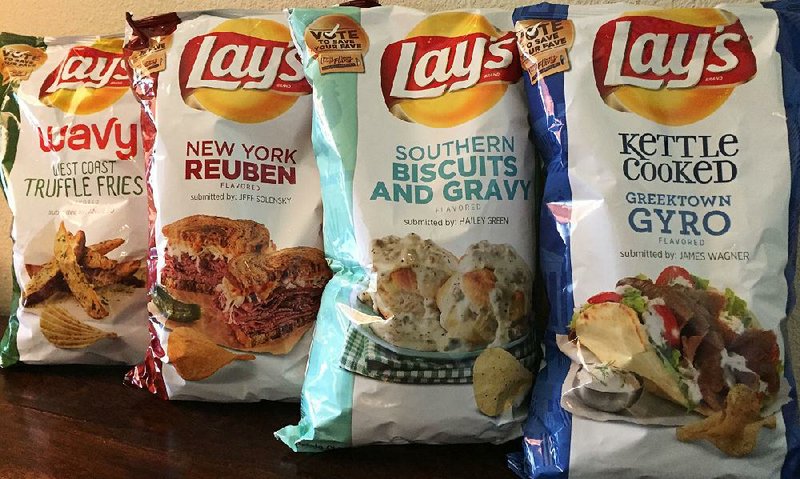Must. Have. Crunch. No matter which meal, whether the food's savory or sweet. It's a reasonable demand of mine, given the many foods that offer such texture naturally, and the many techniques the food industry uses to introduce it.
Crunch Nation might not be an official movement, but its members are loyal and legion. Adeena Sussman could lead the pack. The recipe developer, cookbook author and former restaurant critic is so obsessed that she began a series for FoodRepublic.com in 2014 called Crispianity, featuring surefire techniques and dishes that deliver crunch.
"It's the underappreciated enhancer and my most favorite food attribute," she says. "That extra play in the mouth creates a clarity. When you bite into something crunchy, you think about what you are chewing on." Obviously, Sussman has thought enough about crunch to parse it from, say, foods that are simply crisp.
"Crispy's a shattering sensation, where crunch is a denser, deeper one. A Lay's potato chip is crisp. A kettle chip delivers crunch."
Science backs me up on this -- not that I need the validation. Take one study that looked at the crunch-loving cuisine of the Tamil community in Malaysia; suffice it to say that the explanations and language are nerdy enough to differentiate between "crispy/dry" (as in, snacks) and "soft/dry" (as in, fried main dishes). A summation of that study: "The crunchy sensation produced when eating crispy foods evokes strong ideas of play, pleasure and delight ... as it allows for extended mastication and the use of the muscles around the mouth."
Oxford professor and Ig Nobel Prize winner Charles Spence continues his work on the key role that the sound of crunchy food plays in our very enjoyment and perception of flavor. In his 2015 "Eating With Our Ears" article, published by the online journal Flavour, he relates the specifics of late-1980s market research on the chocolate coating for Magnum brand ice cream bars. In solving the problem of making a coating that stuck, research and development types got rid of the distinctive snap the chocolate made when consumers bit into it. Bottom line: The original formula had to be reinstated because consumers preferred the audible, edible crunch over chocolate that stayed put.
Some paleo devotees buy into the theory that humans are hardwired to savor the crunch factor, it being synonymous in hunter-gatherer times with foodstuffs that were nutritious. At the least, you might find in your own eating history that you were always digging for those bits in the corners of baking pans (like Sussman and I).
John McQuaid, journalist and author of Tasty, says a preference for so-called "loud food" is more of a learned experience. "In the daily parade of food sensations, most of what we eat is soft," he says. "The body and brain learn to like and anticipate the novelty of an opposing texture, like crunch, over time as something good and interesting. And you want more of it."
Of course, on almost any night of the TV week you can hear cooking competition judges -- chefs especially -- tsk-tsk about the crisp or crunchy element missing in a contestant's creation. "We always think about how to add texture to a dish," says Scott Drewno, executive chef at Source, Wolfgang Puck's Asian restaurant in Washington.
The executive chef's current weapons of choice: panko toasted in duck fat, and crispy fried garlic. For him, one of the joys of the Chinese food he cooks daily is its great disposition of crispy, crunchy and chewy all in the same dish.
"I think about why I love potstickers so much, and it's not because they are porky and fatty," Drewno says. "It's because they are chewy on one side and crispy on the other."
Crunch can certainly signify freshness, a positive food attribute. Chef Art Smith says his five children, who range in age from 6 to 15, seek that brightness on the plate as much as any restaurant guest. Vegetables at his house are served raw or crisp-tender, at best.
Venerated French chef Michel Richard was an early adapter of adding crunch to a soft dish such as risotto, via a garnish of Rice Krispies, and wrapping fish in the shredded Mediterranean pastry called kataifi. These days, his crunch repertoire is manifested in the potato tuiles on his burger at Central, his Washington bistro. "When food goes to your mouth, the crunch gives it excitement!" he says. "I love the textures of crunch and moistness together. My first introduction to crunch was KFC when I was a young chef in America, and my fried chicken is still my favorite."
Of late, Sussman has been using leftover rice to make fried cakes as platforms for sauteed vegetables. She heats oil in a cast-iron skillet, salts the cold rice and forms it into a ball, then presses it into a wafer in the hot pan and cooks it until it's as browned and crunchy as she likes. (I'm on it.) Drewno is into fried onion dips at home.
The rest of us can toss nuts and seeds into salads and stir-fries; crumble potato chips into cookie dough; sprinkle flakes of Maldon sea salt on steak; slip crisp pickle slices into sandwiches; and roll tempura shrimp inside sushi.
Style on 02/09/2016

